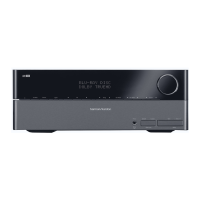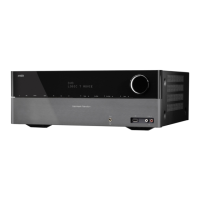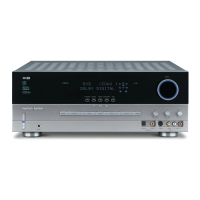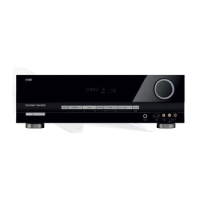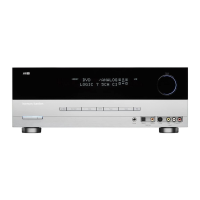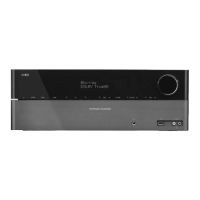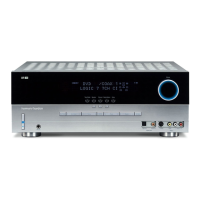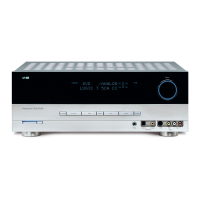29
ENGLISH
AVR
Operating Your AVR and
Advanced Functions
Playing Media from a Roku Streaming Stick
When you connect a Roku Streaming Stick to the AVR’s MHL/HDMI input and join it
with your home Wi-Fi network, you can use the AVR’s remote to search for and control
streaming media. NOTE: Your home network must be Wi-Fi for you to be able to use the
Roku Streaming Stick with your AVR.
1. After connecting the Roku Streaming Stick to the AVR’s MHL/HDMI input, select the
AVR’s MHL source. The Roku Streaming Stick’s video output should be displayed on
your TV.
2. Follow the Roku instructions for joining the Roku Streaming Stick with your Wi-Fi
network, using the Roku remote.
3. Once the Roku Streaming Stick is joined with your Wi-Fi network, the AVR remote
buttons shown below will perform the same functions as their counterparts on the
Roku remote:
Home Menu
Previous
Menu
Menu
Navigation
Menu Item
Selection
MHL Source
Button
Advanced Functions
Much of the adjusting and configuration your AVR requires is handled automatically, with
little intervention required on your part. You can also customize your AVR to suit your
system and your tastes. In this section we will describe some of the more advanced
adjustments available to you.
Audio Processing and Surround Sound
Audio signals can be encoded in a variety of formats that can affect not only the quality
of the sound but the number of speaker channels and the surround mode. You may also
manually select a different surround mode, when available.
Analog Audio Signals
Analog audio signals usually consist of two channels – left and right.
Your AVR is able to
process two-channel audio signals to produce multichannel surround sound, even
when no surround sound has been encoded in the recording. Among the available
modes are the Dolby Pro Logic II/IIx/IIz, Virtual Speaker, DTS Neo:6, HARMAN NSP,
5 CH and 7 CH Stereo modes. To select one of these modes, press the Surround
Modes button.
Digital Audio Signals
Digital audio signals offer greater flexibility and capacity than analog signals, and
allow the encoding of discrete channel information directly into the signal. The result is
improved sound quality and startling directionality, since each channel’s information is
transmitted discretely. High-resolution recordings sound extraordinarily distortion-free,
especially in the high frequencies.
Surround Modes
Surround-mode selection depends upon the format of the incoming audio signal as well
as your personal taste. Although there is never a time when all of the AVR’s surround
modes are available, there is usually a wide variety of modes available for a given input.
Table A12 in the Appendix, on page 47, offers a brief description of each mode and
indicates the types of incoming signals or digital bitstreams the mode may be used with.
Additional information about the Dolby and DTS modes is available on the companies’
Web sites: www.dolby.com and www.dtsonline.com.
When in doubt, check the jacket of your disc for more information on which surround
modes are available. Usually, nonessential sections of the disc, such as trailers, extra
materials or the disc menu, are available only in Dolby Digital 2.0 (two-channel) or
PCM two-channel mode. If the main title is playing and the display shows one of these
surround modes, look for an audio or language setup section in the disc’s menu. Also,
make sure your disc player’s audio output is set to the original bitstream rather than two-
channel PCM. Stop play and check the player’s output setting.
Multichannel digital recordings are produced in five-channel, six-channel or seven-
channel formats, with or without a “.1” channel. The channels included in a typical
5.1-channel recording are front left, front right, center, surround left, surround right and
LFE (low-frequency effects). The LFE channel is denoted as “.1” to represent the fact that
it is limited to the low frequencies. 6.1-channel recordings add a single surround back
channel, and 7.1-channel recordings add surround back left and surround back right
channels to the 5.1-channel configuration. New formats are available in 7.1-channel
configurations. Your AVR is able to play the new audio formats, delivering a more exciting
home theater experience.
AVR 1710/AVR 171 only: To use the 6.1- and 7.1-channel surround modes, the surround
back channels must be enabled. See Manual Speaker Setup, on page 30 for more
information.
Digital formats include Dolby Digital 2.0 (two channels only), Dolby Digital 5.1, Dolby
Digital EX (6.1), Dolby Digital Plus (7.1), Dolby TrueHD (7.1), DTS-HD High-Resolution
Audio (7.1), DTS-HD Master Audio (7.1), DTS 5.1, DTS-ES (6.1 Matrix and Discrete),
DTS 96/24 (5.1), two-channel PCM modes in 32kHz, 44.1kHz, 48kHz, 88.1kHz, 96kHz,
176.4kHz or 192kHz, and 5.1 or 7.1 multichannel PCM.
When the AVR receives a digital signal, it detects the encoding method and the number
of channels, which is displayed briefly as three numbers, separated by slashes (e.g.,
“3/2/.1”).
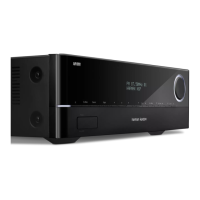
